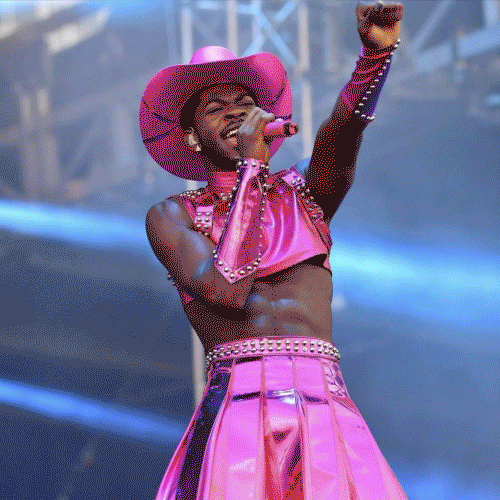Honey, You Know Where to Find Me
On Friday, June 26th, the line to enter beloved Atlanta arts critic and vinyl-enthusiast Andrew Alexander’s choreography showcase / karaoke dance party wound out the door, distinguishing the entrance to The Lucky Penny’s event in the future home of Digital/Analog from that of its more ubiquitous neighbor, Octane.
At the door, attendees were stuck with pins featuring an image of Judy Garland backstage at the Greek Theater in June of 1957, poised in front of her vanity, the curve of her career marked by the highly-arched brows she contemplates. The evening’s program printed thoughtfully on fans gave guests at least the illusion of control over the stifling midsummer heat in the packed house, plus a convenient, socially-cued habit for recovering smokers.
Three stages punctuated the room, providing mysterious markers for the early arrivers, who uncertainly swarmed in circles under Aubrey Longley-Cook’s installation of reflective and printed banners and disbelief-suspending floating hula hoops. The bar provided complimentary beers and maraschino cherry–topped “Sweetie Pie” mixed drinks (a nod to curator Andrew Alexander’s undying love for Morrissey) to help patrons cool off and prep their nerves for the specter of karaoke to come.
T. LANG
The Smiths’ “The Queen is Dead” kicked off the first performance, choreographed by T. Lang. Five dancers (Indya Childs, Toi Pearson, Sharel Johnson, Mickael McNeil, and Okwae Miller) assembled on the far corner stage, all wearing slick red metallic pants and long, fringed tops. Flashing and frenzied, the dancers, once released, exploded outward rhythmically, as if pinballs ran through their limbs. The performers seemed to be running through obstacle courses in the mud and rain, alternately vigilant on their feet and scrambling on the floor, all the while pulling faces marked by varying degrees of indomitable, strained perseverance.
Penetrating the audience, the dancers spilt from the first stage across the room like hot lava. The use of multiple stages effected controlled chaos as the movements multiplied and flowed, the joy and rage of those red pants unstoppable and potent as they moved through defined solo work in Minnie Riperton’s sexy and triumphant “Les Fleurs,” and back home into The Smiths for more dynamic group choreography alongside “There Is a Light That Never Goes Out.”
CORIAN ELLISOR
Corian Ellisor’s choreography followed, introduced with a smoky Cyril Hahn remix of Destiny’s Child’s “Say My Name.” Performing with Shawn Evangelista and Nicholas Goodly, the artist also known as Ellisorus Rex oozed glamour with black and gold lamé, sequins, fainting, and fans, parading as a hot and bothered queen with her eager attendants—the flirtatious Evangelista and courtly Goodly—in unbreakable, unabashed character. The troupe exited after the first song, a tease for their later reappearance.
MARYGRACE PHILLIPS
Beginning with “Are You Lonesome Tonight?” by Elvis Presley, MaryGrace Phillips elegantly embodied the wanting woman in red. A thinker’s fist held delicately to her chin rose deliberately to her forehead as she reared back her bare feet against the ground—a bull preparing to charge in slow motion—before coming undone. Stumbling forward she nodded yes, yes in response to the unseen crooner’s question.
During Peggy Lee’s “Me and My Shadow,” Phillips held hands with herself behind her back, leading herself around the stage in vicious circles. Testing out her breath on her shoulder, she gained reckless confidence in her feet before falling into a pin-up pose.
In a devastatingly still moment of “It Never Was You” by Judy Garland, Phillips stood, arms outstretched, motioning almost imperceptibly to an unseen, unresponsive lover. Beckoning with outstretched hands, she parted her lips and voicelessly urged: come to me.
Phillips’s most breathtaking movements manifested in the smallest shifts of her hands and face, as when she mimed wiping off her lipstick and removing her earrings before turning to face the wall, spreading her arms like wings behind her. Asked later for the thread unifying her three songs, she—with an unblinking gaze—answered simply: “Loneliness.”
ERIK THURMOND
Erik Thurmond’s first song, “Teenage Castle” by Peggy March, began with him seated motionless in a chair. As the singer’s tower came “tumbling down,” Thurmond propelled himself onto the floor and went limp. Luxuriating in the torment of rejection, he remained in the fetal position for the remainder of the verse, then slowly rolled over and over as March’s haunting questions hung heavy in the air: “Why would you say goodbye / Oh, what went wrong / Did I lie / Oh, what is love / Love is gone / Gone with my castle above.”
Overcome, he spent the chorus lying face down on the floor, immovable. As the background singers chimed in, Thurmond—in millimeters—dragged himself back into motion, rolling down to the end of the stage until the reappearance of March’s vocals froze him again on his side for the remainder of the song. Essentially, Thurmond fell out of a chair and rolled from one end of the stage to another, but orchestrated each moment with a strikingly spontaneous sense of inevitability and responsibility to the music.
Thurmond’s second piece, “Chopin Nocturne Opus 9 No. 1 in B-Flat Minor” as played by Arthur Rubinstein, started with him on his hands and knees, his forehead on the seat of the chair. As if awakening from a slumber—or into a daydream—Thurmond raised his head, looking around with wide-eyed wonder before rising and repositioning himself with the unselfconscious yet hesitant gait of a kindergartener approaching the front of class. Small movements spread, his body appearing to be thrown by outside forces, until he suddenly blocked his face defensively with his arms as if to say no, too much!, and stay the rising intensity.
The simplicity of the series of choreographed failures that followed belied the control implicit in these planned accidents. In between his stops and starts, Thurmond coached himself with youthful, innocent optimism. As he attempted and faux-flubbed more complex maneuvers, he looked apologetically at the audience, but so too expressed pride, almost elation, with each successful movement. The piece provided insight into a dancer’s world: the effortless control over each vertebrae surely having come after endless hours of practice, pressure, and performance. Thurmond ended the song again on the ground.
Bach’s “Invention No. 2,” performed by Glenn Gould, opened with Thurmond seated in a chair. His feet assumed a life of their own, jutting out as if they might run away without him. His arms closed around mimed objects and tools and cut through space. Thurmond’s confident assertiveness interacting with and participating in his environment from the beginning of this incredibly detailed piece stood out against the measured steps of the first and second songs building up to it.
Thurmond sat on his knees, bouncing with anticipation and slowly raising his hand, like a star student eager to be called on again. Compelled by that very rising hand back into the dance, Thurmond lifted himself in one swift movement from the ground and bubbled up and out back onto his feet, weightless and whimsical.
Climaxing the piece with his fist raised in the air triumphantly, Thurmond shifted his fascination to his opening palm. Leading more dangerously with his eyes on his outstretched hand, Thurmond expressed losing track of the atmosphere he had acclimated to and—only then—fell, and fell again, ending the song once more on the floor.
Of his white shirt, blue jeans and bouncy ponytail Thurmond later giggled, “Am I a little boy? Am I a little girl? I don’t know!” When asked what his vision was tying these three pieces together, the irrepressible Thurmond answered enthusiastically and openly: “Growing up!”
CORIAN ELLISOR
Ellisor returned with Evangelista and Goodly for “Iris, Hence Away” as performed by Joan Sutherland, splicing comedy and camp with tenderness. Intoxicated by his own splendor and the eyes of the audience, Ellisor coquettishly fanned himself, slowly appearing more and more overheated, until collapsing on the floor. Evangelista and Goodly ran to the queen’s aid, but their simple fans wouldn’t do. Only when they returned with an oversized, ornate fan was Ellison sufficiently soothed and roused from decadent delirium onto his feet again.
The third piece, “Casta Diva” as performed by Montserrat Caballe, unfolded in a duet between Evangelista and Goodly. The recurring pose of the two, standing side-by-side, gazes parallel, slowly and nervously hazarding their hands toward each other, provided a grounding movement after the levity of Ellisor’s previous two pieces. The placement of their hands recalled an altered birth of Adam: the roles of divine and human, desired and desiring, in flux (and hence more perfect). The nervous experimentation developed into focused passion, as Evangelista’s and Goodly’s movements grew more in tune yet turned outward, bowing, dipping, and jubilant.
BLAKE BECKHAM and JOSHUA RACKLIFFE
Blake Beckham, co-founder (along with Malina Rodriguez) of The Lucky Penny, choreographed Morrissey’s “Sweetie Pie” with performer Joshua Rackliffe. Asked about his inspiration in interpreting Beckham’s work, Rackliffe answered: “Surrender. Surrendering to the audience.”
This surrender was evident in Rackliffe’s vulnerable gaze, directed out steadily and mercilessly into the crowd, the ceiling, or the walls as he purposefully folded and unfolded his body to Morrissey’s vocal caresses. He bent with the grace of a peacock stretching its plumage, his long body remaining pliable as taffy even when holding carefully sculpted poses.
KARAOKE
Bridging into the karaoke party, Rackliffe rose again and lent the supportive rite of dancing while Lam Nguyen belted out “Crying” by Roy Orbison. (The classically-trained Lam revealed later that his interpretation was based on KD Lang’s version.) MaryGrace Phillips and Erik Thurmond followed with “Shame Shame Shame” by Shirley and Company, the tongue-in-cheek lyrics taunting: “Shame on you / If you can’t dance too.” Ellisor, Evangelista, and Goodly lined up next, executing an amazing rendition of Whitney Houston’s “I Wanna Dance with Somebody,” that prompted my date to lean in and whisper: “This is some seriously high-stakes karaoke.”
ANDREW ALEXANDER
Yet the feeling of the night, despite the star-studded performances, was casual, playful, and absolutely loving. Everyone with whom I spoke about Alexander respectfully enthused that they had known him for years, had been supported by him, and worked with him in the arts community.
When asked about his relationship with the artists he collaborated with for the evening, Alexander echoed back the kind sentiments: “These are all people who I’ve been following for years . . . whose work I am excited about.”
Alexander elaborated in his Curator’s Statement printed on the fan programs:
“These artists have very little in common. The work they create is singular. What they do have in common is their unswerving presence, their swift clear seeing and their ability to create work that’s specific and personal but also an open vessel for the viewer’s mind to wander into freely. I admire them for their insane devotion, their sweat, their wonder, their elation, their presence. That is what I know they will bring to this evening. It is a gift from them to you.”
A lifelong lover of records, Alexander began collecting in childhood and “never stopped.” When CDs entered the scene (“You’re too young to remember this,” Alexander said charitably, briefly inspiring my envy as I noticed his cherubic complexion), they were too expensive, so he stuck with vinyl.
All humility and warmth, Alexander wasted no time in expressing his appreciation also to me (“I’m so glad you’re here; you’re doing what I would normally be doing!”) and WUSSY (“I was a wussy long before there was a WUSSY”).
SAME-SEX MARRIAGE RIGHTS
Contributing to the feel-good vibes of the evening was, of course, the rainbow elephant in the room, the US Supreme Court’s 5-4 ruling on same-sex marriage as a right earlier that day (a source of joy in a week of less helpful decisions). On the coincidence of the historic day falling on this his shining curatorial moment, Alexander beamed. “I am beyond words. I feel like Judy is smiling down on us.”
Be on the lookout for The Lucky Penny’s new dance studio opening in East Point, The Work Room.
Check out more images from the night below!
ABOUT THE AUTHOR
Catherine Rush currently lives and works with the arts connective not for human consumption at 368 Ponce de Leon Ave NE, Porpoise Christy, Atlantis (also know as the Big House on Ponce).
PHOTOGRAPHY
All images provided by Austin Frantz and Aubrey Longley-Cook.
Archive
- February 2025
- November 2024
- October 2024
- September 2024
- August 2024
- July 2024
- June 2024
- May 2024
- April 2024
- October 2023
- July 2023
- June 2023
- May 2023
- April 2023
- March 2023
- February 2023
- June 2022
- April 2022
- March 2022
- January 2022
- December 2021
- October 2021
- September 2021
- August 2021
- July 2021
- June 2021
- May 2021
- April 2021
- March 2021
- February 2021
- January 2021
- December 2020
- October 2020
- September 2020
- August 2020
- July 2020
- June 2020
- May 2020
- April 2020
- March 2020
- February 2020
- January 2020
- December 2019
- November 2019
- October 2019
- September 2019
- August 2019
- July 2019
- June 2019
- May 2019
- April 2019
- March 2019
- February 2019
- January 2019
- December 2018
- November 2018
- October 2018
- September 2018
- August 2018
- July 2018
- June 2018
- May 2018
- April 2018
- March 2018
- February 2018
- January 2018
- December 2017
- November 2017
- October 2017
- September 2017
- August 2017
- July 2017
- June 2017
- May 2017
- April 2017
- March 2017
- February 2017
- January 2017
- December 2015
- November 2015
- October 2015
- September 2015
- August 2015
- July 2015
- June 2015
- May 2015
- April 2015


























